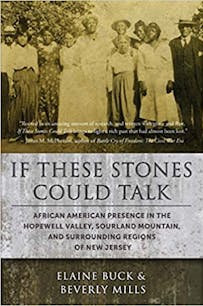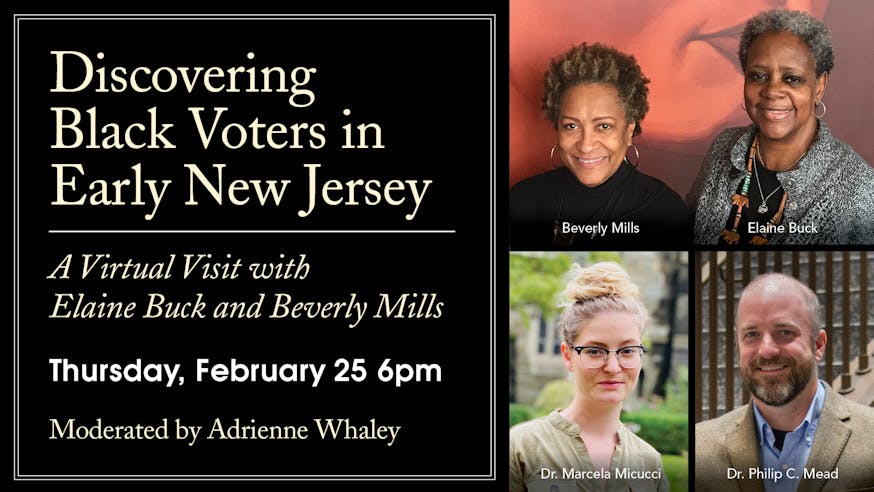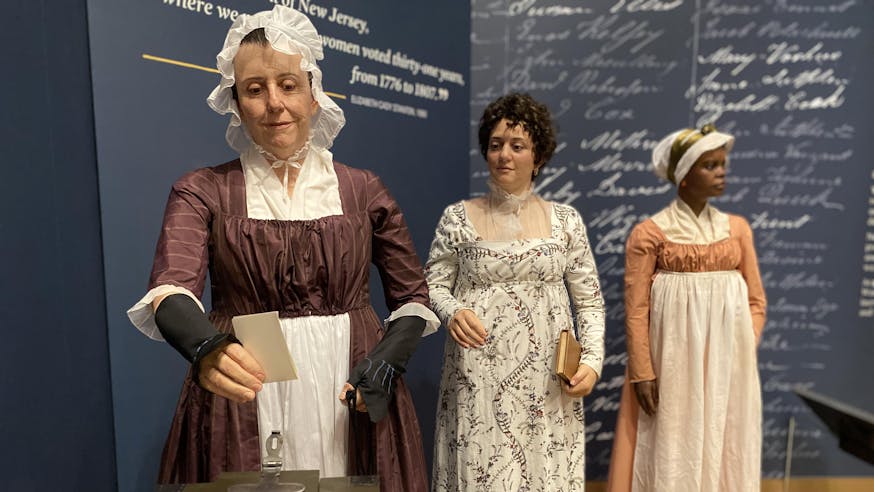Read the Revolution
If These Stones Could Talk
February 24, 2021
Purchase the book from Barnes & Noble.
In If These Stones Could Talk: African American Presence in the Hopewell Valley, Sourland Mountain and Surrounding Regions of New Jersey (2018), Elaine Buck and Beverly Mills, both founders of the Stoutsburg Sourland African American Museum (SSAAM), repeatedly reference the likely source of their region’s unusual name: the acrid, depleted soil and the seemingly inhospitable land upon and surrounding Sourland Mountain. Yet, the soil sustained generations of hopes and dreams for enslaved and free people of African descent, and saw their homes, lives, and families built upon it. Later, it became the resting place for those who transitioned to become the ancestors of younger generations. The following excerpts allow us to see the history embedded in this landscape as it continues to live and have life breathed into it by Mills and Buck in their work as educators, preservationists, and advocates for their community’s Black history.
In the first excerpt, from Chapter 4, Mills uses a mix of historical insight born from painstaking historical research and imagination born from pure human empathy to try to understand her ancestor Friday Truehart’s connection to Reverend Oliver Hart, who founded the Charleston Baptist Association in 1751, and experience upon first setting foot on the soil in the shadow of Sourland Mountain.
In the second excerpt, from Chapter 7, Buck transports us to a day of community and family celebration and explores what it means to remember the stories of those who have returned to the soil, having served and suffered for the nation’s founding and preservation, with no guarantee – but with hope – that they, too, would reap the benefits.
Excerpt 1
In November 1780, while the Stives family thrived on the mountain, the Rev. Oliver Hart arrived in Hopewell from Charleston, South Carolina, to become the new pastor at the Old School Baptist Church. With him was his thirteen-year-old slave, Friday Truehart, who would eventually become my fourth great-grandfather. On December 16, having fled the ravages of the Revolutionary War’s “Siege of Charleston,” the Reverend Hart met his new flock of 220 members: 89 White males, 124 White females, and seven Black congregants. The moment of learning the circumstances behind Friday Truehart's arrival to Hopewell has been one of the most exciting discoveries of my life.
Having another piece of the puzzle revealed about one of my ancestors was astounding. The excitement I felt when I found out that Friday originally came from Charleston was literally life altering. Up to that point, all I'd known was gathered from a notation in the Hopewell Herald announcing the death of Friday's oldest son, Isaac. The Herald noted that “Friday was a native of Africa, and was brought to Charleston, S. C. by the ship's captain, who had stolen him from his native home. He was brought by Oliver Hart of this Captain. Mr. Hart named the African boy after Robinson Crusoe's companion, Friday.”
In my research I was able to find information to refute this misinformed narrative—I found a different narrative that surprisingly brought me more comfort. This narrative arose from my reading of Oliver Hart's papers, which encompass Hart’s correspondence, diaries, and sermon notes from the colonial and Revolutionary period while he lived in Charleston. Plowing through Hart’s writings was, at first, slow and boring work. Most of his records seem almost perfunctory: recounting of sermons and letters describing the conditions in the area, his travels to Virginia and North Carolina, and his patriotic work in South Carolina's low country during the earlier days of the Revolution. There was virtually no mention of his tracts of land or his plantation which comprised 350 acres near Charleston and an additional 300 acres in St. Mark’s Parish. But then I came across his diary.
There is no explanation why, in 1949, Oliver Hart’s diary was found transcribed in an old notebook kept by William G. Whilden of South Carolina. But I immediately devoured the document as I looked for clues that might tell me anything about Friday Truehart. As with his other documents, Hart’s notations were short and to the point. I read two lines about his marriage to Sarah Brees and a brief announcement about the birth of his children, but what I found more interesting was his elaboration regarding his countryside travels and the deathly typhoon of 1761. I continued reading, slightly bored, until I came upon an entry for April 9, 1771. The closest way I can come to explaining how I felt when I read this entry is elation that quickly turned to sorrow. Here before me was a key to a family mystery, but these words also made me face a stark and difficult reality I wasn't prepared to read, “Dinah and her son Friday were bought April ye 9th 1771. Dinah was then supposed to be about twenty years of age. Friday was born May ye 29th 1767. The two cost 356 pounds.” Further down on the page I read another entry, “Dinah was delivered of a daughter August ye 22nd 1772."
It's hard to imagine how young Friday Truehart felt when he came to the realization that Hopewell would now be his home; it must have been a shock leaving the sun-kissed warmth of South Carolina to arrive in the frosty chill of the Northeast. How were crops to grow in the cold, unforgiving soil that greeted him upon his December arrival? Was there snow on the ground? Who was there to mother this thirteen-year-old boy? How long did his mother, left behind to serve the family of Hart’s daughter-in-law, mourn the loss of her boy? Did she ever forget how her boy looked and smelled? Did she remember things about him that only a mother would know and hold dear? Did Friday ever forget his young mother's face, her voice, and her touch? Was he frightened or awestruck when he first saw the gigantic boulders that dotted the Sourland Mountain landscape? How did he make sense out of any and all of this? The Parsonage Farm, which Oliver Hart was to call his new home, was controlled by the Stout family. Presumably this homestead was located in what was known as the Blackwell/Riley/Drake farmstead. On December 25 Reverend Hart settled in the Parsonage House on Parsonage Farm (as it was referred to in the diary of Oliver Hart) to lead the Old School Baptist congregation. Hart’s wife, Anne, who had remained in Charleston, joined him a year later in the sleepy New Jersey hamlet. Along with the parsonage, an additional ninety-five acres had previously been purchased by the Baptist Trustee Board. I imagine Friday's duties revolved around the day-to-day running of the farm. The typical colonial era farm would include the main house, a barn a shed or sheds, areas for livestock, places to store crops and corn, and a smokehouse and springhouse. From sunup to sundown the Hart Hopewell plantation would have required more than just Friday to keep a farm of that size efficiently running. Unfortunately, our research has not been able to discern the names of other slaves or free Black people who may have worked alongside Friday. Nevertheless, this farm is where Friday would be enslaved until granted his freedom in 1802.
Oliver Hart spent the remaining fifteen years of his life as the spiritual leader of the Old School Baptist Church, which still stands on Broad Street in Hopewell, New Jersey. More austere on the inside than on the outside, the building can be startling for first-time visitors. The creaky floors are slightly sloped and the pulpit is a simple lectern. I wonder how many sermons Hart preached while gazing up at the balcony where slaves were required to sit. How many Sundays did Friday sit in the balcony listening to his master preach on God's goodness and grace? Oliver Hart had been suffering failing health long before his demise in December 1795. In Hopewell Valley Heritage author and curator of the Hopewell Museum Alice Blackwell Lewis wrote about the death of Reverend Hart by saying, “Rev. Hart had a faithful and trustworthy slave. Because of his fondness of this man, he called him Friday True. Later this servant wished to have the name of this master added, so he called himself Friday Truehart.” This is one of many legends of how Friday’s surname came to be and prompted me to conduct further research in the hope of gaining more information about Friday's decision to honor his master by adding “hart” to his last name. Unfortunately, I have not been successful.
I was presented with more answers to my questions after I read the will of Oliver Hart, who started out declaring himself “an unworthy Minister of the glorious Gospel.” I read Hart’s small, beautifully handwritten script that enumerated each bequeath upon his death. The will also answered the question of the fate of Dinah, Friday's mother, where he apathetically instructed, “My Will is, that Sarah, the widow of my late son, Doctor Oliver Hart, shall keep and have the use of one Negro woman now with her named Dinah, during the widowhood of her life, the said Sarah; but in case she should marry, then the said wench should be sold, and the money arising therefrom be disposed of as follows, that is to say, it shall be put out on interest, and the interest arising therefrom shall go toward the maintenance of the children which my son has left until the youngest of them shall arrive at the age of eighteen years the principal shall be divided between them, share and share alike.
I surmised that the “Dinah” mentioned was Friday's mother, who remained behind within the family. Since the will was probated in 1796 this would mean that Dina, if sold should Sarah remarry, was still relatively marketable as a slave woman approaching middle age. How much would she have fetched toward “the maintenance of the children”? While Hart was providing a financial legacy for his grandchildren with the potential sale of Dina, it occurred to me that Friday, when freed, would not have seen his mother in twenty-two years and most likely never laid eyes upon her again. Yet another item literally took my breath away when I read, “I give and bequeath into my son John Hart, one Negro man, named Friday; also my watch with the chain and seal, likewise a silver soup spoon and a silver pepper box, together with a seal set in gold on which our family coat of arms is engraved; to him and to his heirs forever.
I read and reread this entry, all the while trying to wrap my mind around such a stunning example of how the fate of a human being was controlled by the stroke of a pen. I continued reading until I came to the end of the will, which contained a surprising codicil written in January 1793: “Whereas by the above will I have given and bequeathed my Negro man Friday to my son John Hart, I do hereby revoke that bequest, and my will now is that the said Negro Man Friday shall be fully and absolutely free, at the expiration of seven years after my decease. During which term of seven years, said Friday shall be under the care and control of my dear wife, Anne Hart, to dispose of his time or labor, or any profits arising therefrom, as she may think proper.” After seven years under the “care and control” of Anne Hart, Friday would finally be freed at the age of thirty-five.
I have no information as to the circumstances under which Friday and Judah (or Juda) Shue of Somerset County met and married, but it was definitely before 1802 when he was still under the “care and control” of Hart’s widow. Friday and Judah welcomed sons Isaac in 1792, Aaron in 1805, and Moses in 1816. Life for the Truehart family began in the Sourland Mountain in a log cabin that still stands today.
Excerpt 2
Every year since the late 1960s, on the grounds of the Stoutsburg Cemetery, with the flag raised high in the early summer, while peonies are often blooming, we host a Memorial Day Service. The event, which draws community members near and far, not only honors but also gives voice to the accomplishments of local unsung heroes, are African American veterans. Stoutsburg cemetery has been situated at the foot of the Sourland Mountain, in Hopewell Township across the border from Montgomery Township, for close to 300 years. Flags waving in the gentle breeze adorn the graves of American Revolution, Civil War, World War I, World War II, and Vietnam veterans as well as others who served our country in times of peace. This Cemetery is a final resting place of African American trail blazers.
Through the years, our Memorial Day services have also united descendants, Black and White, of the region’s families—and have acted as a glue to bond people together. In our role in arranging these Memorial Day services, Beverly and I have repeatedly felt gratified to act as catalysts for bringing together descendants from local families like the Hoaglands, Trueharts, and Crays, to name a few. In a moving ceremony in 2017, we watched the African American side of the Stives family meet some of the White family members for the first time, on the most appropriate occasion of Memorial Day.
Each new connection, each shared memory is proof of how interrelated we are. Only together can we begin to break the cycle of America's historical omissions, such as the story of African American military service. Memorial Day is our day to reflect and uphold the most honorable of those who have gone before us.
Read the Revolution is sponsored by The Haverford Trust Company.
Read the Revolution is published biweekly by the Museum of the American Revolution to inspire learning about the history of the American Revolution and its ongoing relevance.
Sign Up
Get biweekly Read the Revolution featured excerpts right to your inbox.
Tags
Learn More

Discovering Black Voters in Early New Jersey with Elaine Buck and Beverly Mills

When Women Lost the Vote: A Revolutionary Story
October 2, 2020 - April 25, 2021

